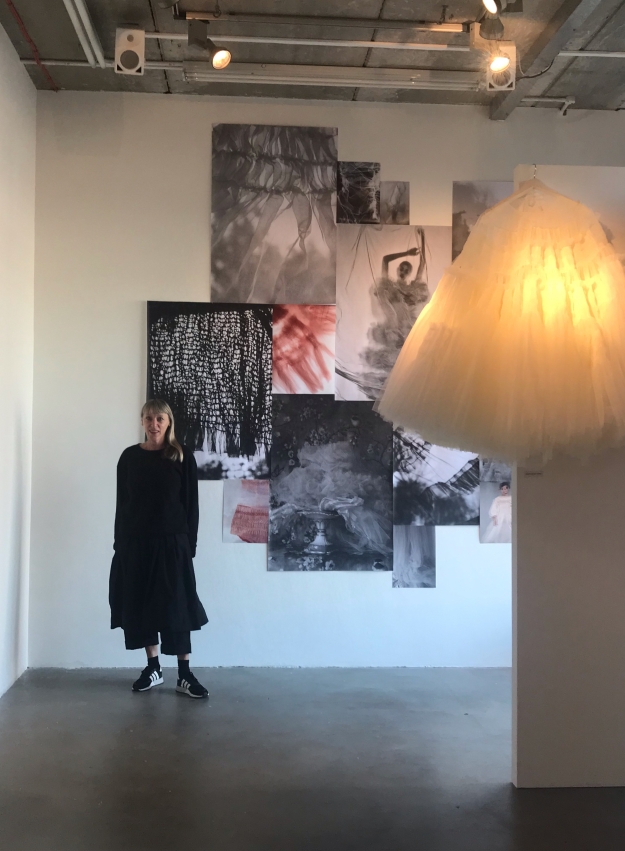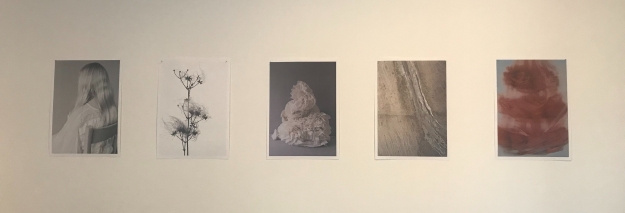
Details on tunic for La Bella au Bois Dormant (The Sleeping Princess), designed by Leon Bakst. Image © Seowon Nam
Curated by MA Curating and Collections
On 17 March in the Exhibition Studio Workshop, MA Curating and Collections presented their research project on Ballets Russes costumes from the Archive and Special Collection Centre at LCC. Due to open at the Triangle Space in Chelsea College of Arts on the 24th March as an exhibition of costumes from varying Ballets Russes productions the venue and nature of the show were forced to change due to the current health crisis. Ballets Russes: Concealed Histories presents a survey of the dance troupe’s textile pieces, showcasing myriad details that contributed to their recognition as one of the most influential ballet companies of the 20th century. The project examines how these costumes offer a historical and contemporary reconsideration of the ballet troupe in terms of its design, choreography and music.
On display is research and detailed photographs of 9 costumes from varying productions; from headpieces to jackets. Ballets Russes: Concealed Histories chronicles the influence of Ballets Russes, showcasing traces left by a past performer. Through different marks on the costumes show how Sergei Diaghilev challenged the classical choreography of 19th century ballet, one of simplicity and romance. On display within the research project is a study of a headdress worn for Le Dieu Bleu (The Blue God), devised by Leon Bakst. Its trailing shawl, metal circular medallions and sweat stains in the lining suggest that dancers had to withstand jangling accessories and heat from wearing it. Most of them loathed the costumes due to its inconvenience, on top of the ‘unrefined’ choreography of stomping and jumping. These heavily contrasted the elegance of conventional ballet, shaping new perspectives of the dance form.

‘Ballets Russes: Concealed Histories’ installation view. Image © Seowon Nam
Diaghilev yearned for Ballets Russes to reflect a life that was consistently changing. His dancers used their body as a channel for documenting universal narratives beyond the stage, as shown through costume designs and imprints found on them. He took ballet to new heights of expression and fluidity, as he commissioned innovative composers and designers who redrew the boundaries of ballet in a modern way. Oriental motifs on the garment by Henri Matisse for Le Chant du Rossignol (The Song of the Nightingale) depict a cultural exchange between the East and West, penetrating deeper into various walks of life. This too, was reflected in most of their music that will be played in the background of the exhibition.
Presented in the exhibition will also be a study of a tunic with floral motifs for La Bella au Bois Dormant (The Sleeping Princess) that was designed for comfort and free movement. The baggy costumes of Ballets Russes resonated in realms of modern fashion, specifically in the clothing of designer, Paul Poiret, who briefly worked with the ballet company. He was instrumental in liberating women from the restriction of tight corsets, a significant trend to commemorate this moment in time.
Through these costumes, Ballets Russes: Concealed Histories opens up the present to the past, sparking a journey to reflect on the surviving impact of the ballet company.
As with the body and dress, movement and stillness, we note the certain absences and presences within the space. However in the current situation of a public health crisis, we are reminded of the collective endeavour which is art.
Curated by:
Bilal Akkouche, Sara-Ann Barber, Dana Chan, Jiaying Gao, Zehui Gao, Samuel Marshall, Jiashu Zhou, Lei Gu, Ni Gu, Asya Gurevich, Yige Hu, Seowon Nam, Han Yan, Qinru Zhou, Qianjing Yuan, Shin-Hung Liu, Weirui Liu, Yannis Lo, Elisavet Logotheti, Reece Woodhams, Carolina Fontes, Celina Loh, Hao Long, Junyu Lu, Cara Salmon, Conor Smyth, Ruiying Wang, Ola Talib, Jiachuan Wang, Yi Wang, Pei-Yu Wu, Zhe Wu, Shu Zhang.Special Thanks to:
UAL Archives and Special Collections Centre, Camberwell College of Arts, David Dibosa, Jane Pritchard, Anna Buruma and Judy Wilcocks.Our research on the jacket and dress designed by Henri Matisse for Le Chant du Rossignol (The Song of the Nightingale), was confirmed by Jane Pritchard.












 Destructive Narratives installation view. Image © Yannis Lo Ching Yan
Destructive Narratives installation view. Image © Yannis Lo Ching Yan










